

13 Anti-Bomb Monuments
Around the World
Click here for "peace camps," many of which were (or, in some cases, still are) operated by anti-bomb protestors.
Click here for peace monuments made from weapons. Click here for peace monuments depicting "Swords Into Plowshares" (Isaiah 2:4 & Micah 4:3).Right click image to enlarge.



Memorial Day 1915 - Shillington Monument, Notre Dame University, South Bend, Indiana (USA). "Dedicated just north of Science Hall (LaFortune Hall). Navy Secretary Josephus Daniels [1862-1948] gave an address at the dedication, & much fanfare surrounded the event. The monument consists of a shell from the Maine on a base of red Wisconsin granite. Inscribed: "To the memory of John Henry Shillington [c1875-1898] of Brownson [Hall] who went down with the battleship Maine in Havana Harbor, February 15, 1898. This marker is raised by the men of Brownson as a symbol of their sorrow and their pride. Requiescat in pace." Between 1925 & 1930, the monument was moved closer to the Bronson Hall wing of Main Building. Many students had since forgotten Shillington or knew the reason for the memorial. In 1930, Scholastic [Magazine?] reported that the Brownson Hall residents had taken to calling the monument 'The Bullet,' as do some students even today. The memorial was moved further into obscurity to the south side of the Joyce Center near Gate 8 in 1989. It finally found a prominent home on the south side of the ROTC Pasquerilla Center in the 2000's." Photo c1915-1916.

M
E
M
O
R
I
A
L
June 23, 1919 - Poplar Recreation Ground Memorial, Poplar Recreation Ground, East India Dock Road,London (England). "A memorial to 18 children killed at Upper North Street School in Poplar on 13 June 1917, by the first daylight bombing attack on London by fixed-wing aircraft... A public fund was set up, raising £1,455 to pay for a memorial. It cost [only] £230, so some of the remaining funds were used to pay for the graves of 16 of the children, & the balance to endow a bed in the children's ward at Poplar Hospital, & another at the Lord Mayor's Home for Crippled Children at Alton, Hampshire. Victorian Gothic design, built from marble & granite. A white steeped stone base leads up to a central column of white Sicilian marble, surrounded by four columns of black Labrador granite. The column is surmounted by an angel with spread wings, and inscribed with the names of the children who died."

M
E
M
O
R
I
A
L
June 21, 1936 - "Anti-Air War Memorial," NW of Mornington Road & the High Road, Woodford Green, Essex, near London (England). Bottom image. Sculpted by Eric Benfield in the shape of a bomb for suffrigist (and onetime communist) Sylvia Pankhurst [1882-1960]. Rededicated on July 4, 1936, after being vandalized. "In October 1935, Pankhurst was outraged by Mussolini's assault on Ethiopia, the only part of Africa that remained independent and had joined the League of Nations. Unveiled that same month by a group that included Pankhurst and [Tesfaye] Zaphiro, the secretary of the Imperial Ethiopian Legation, the monument stood prominently outside Red Cottage [which Pankhurst shared with Italian anarchist Silvio Corio] along with a plaque dedicating it ironically to politicians who, at the World Disarmament Conference [which] opened in Geneva in February 1932, 'upheld the right to use bombing planes.'" One of 21 peace monuments named by the PPU website. Named in "A Peace Trail Through London" by Valerie Flessati (1998).




1937 - Guernica, Museo Nacional Centro de Arte Reina Sofía (MNCARS), Madrid (Span). Painted by Pablo Picasso [1881-1973]. Commisisoned by the government of Spain for the Paris International Exposition. Full sized copy (tapestry) at the United Nations in New York City. Click here for other variations.


S
H
E
L
L
November 11, 1938 - Peace Monument, in front of Lyman's Hall, Rollins College, Winter Park, Florida (USA). German artillery shell made into a monument by Hamilton Holt [1872-1951], president of Rollins College. Dedicated on Armistice Day 1938. "Vandalized on Aug. 23, 1943. It was suspected that servicemen from the US Army STAR (Specialized Training and Reassignment) unit stationed on campus were responsible for the act, but investigation did not support that conclusion. The German shell on the stone pedestal was destroyed, but the plaque survived, was put in storage, and was rediscovered in the 1980's under President Thaddeus Seymour, who rededicated it in 1988 by the stairway of the Mills Memorial Building next to Holt’s statue. [Information courtesy of college archivist Wenxian Zhang 10Jan11]" The Plaque bears this inscription: Pause, passerby and hang your head in shame. This Engine of Destruction, Torture and Death Symbolizes: The Prostitution of the Inventor, The Avarice of the Manufacturer, The Blood-guilt of the statesman, The Savagery of the Soldier, The Perverted Patriotism of the Citizen, The Debasement of the Human Race. That it can be Employed as an Instrument of Defense of Liberty, Justice and Right in Nowise Invalidates the Truth of the Words Here Graven. —Hamilton Holt. Compare 1936 monument of Sylvaia Pankhurst in London, England (UK). Did Holt know about Pankhurst's monument?
August 6, 1948 - "Memorial Monument to the Victims of the Atomic Bomb [at] Hiroshima Municipal Girls High School", Peace Boulevard, Hiroshima (Japan). Built by parents at the high school in 1948, dedicated on 3rd anniersary of the bomb, and moved to present location in 1957. Depicts "E=MC squared" because the words "Atomic Bomb" would have been denied by the occupying authorities. Photo by EWL.




1973 - Omega Peace Institute (OPI), Arkansas Avenue, Los Alamos New Mexico (USA). Next door to Black Hole (qv). Former Grace Lutheran Church purchased in 1973 by Ed Grothus [1923-2009]. Includes CND peace sign & two broken bombs. Signs say "No one is secure unless everyone is secure" & "OMEGA PEACE INSTITUTE, FIRST CHURCH OF HIGH TECHNOLOGY, BLACK HOLE SYNOD, Critical Mass Every Sunday with Bomb Unworship Service. Don Eduardo de Los Alamos, Pastor."

M
U
R
A
L
About 1975 - "Wind of Peace" mural, Creek Road, Greenwich, London (England). "Depicts local people rising up to defend Greenwich in a spiral of all races destroying the missiles that threaten London. By Greenwich Mural Workshop & Chris Cardale." /// "GMW’s first project was designing & painting murals with people of Meridian Estate in Greenwich. Three landmark murals were created: 'Peoples River' & the anti-nuclear 'Wind of Peace' on Creek Road & 'Towards the Good Planet' on Thames Street, opened by Oscar winning actress Glenda Jackson."
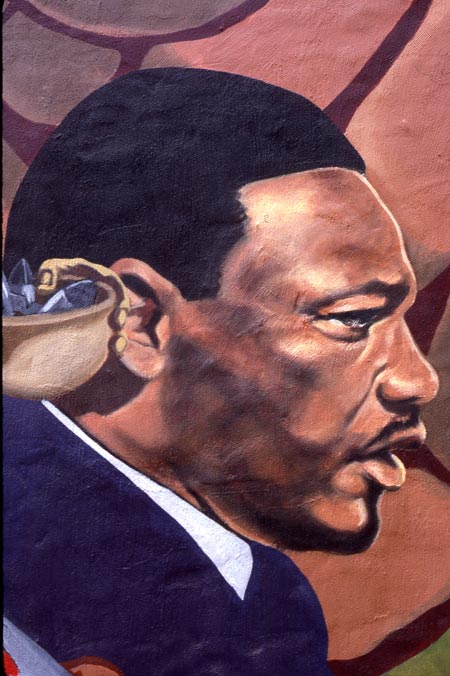
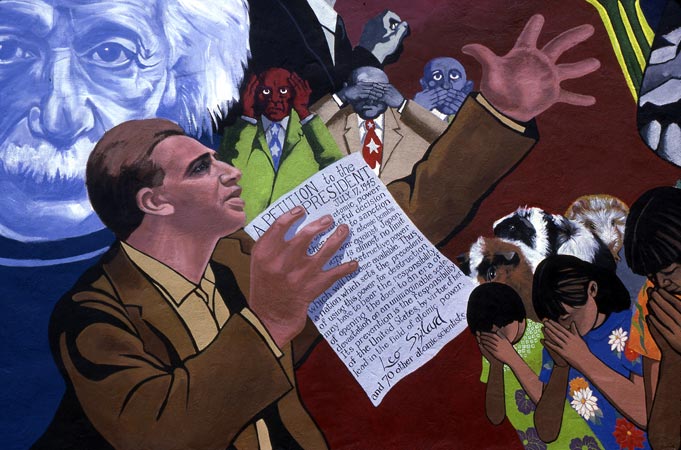
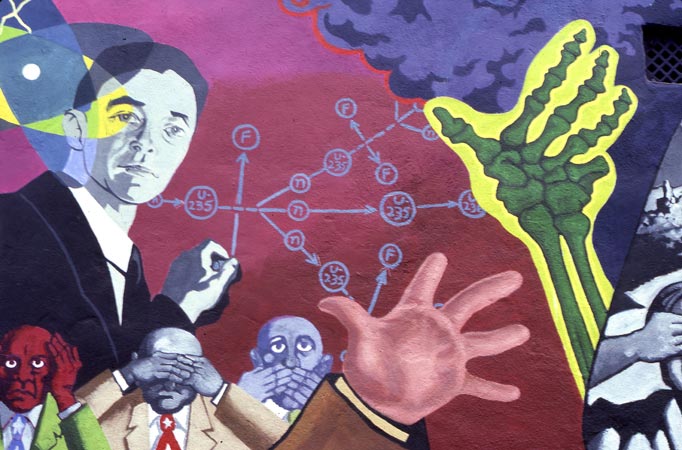
.jpg)
M
UR
A
L
1985-2010 - "Three Minutes to Midnight," Seminole Avenue, Little Five Points, Atlanta, Georgia (USA). Also called the "Seminole Peace Mural." First US mural painted by David Fichter of Cambridge, Massachusetts. "Painted as part of a cultural festival for nuclear disarmament called 'Three Minutes to Midnight' which organized several events around the city in October 1984." First image is close up of Martin Luther King, Jr. [1929-1968]. Second image shows Leó Szilárd [1898-1964] & 70 other atomic scientists petitioning for a demonstration of the atomic bomb before using it on human beings, US officials playing deaf and dumb, and three weeping "Hiroshima maidens". Click here for article & slide show about Fitcher's visit to the endangered mural on December 5, 2008. /// "In December 2008, artist David Fichter & paintings conservator James Squires visited the mural to document the mural's condition, meet with neighborhood leaders & develop a plan to restore it. However, in fall 2010, it was illegally painted over by a graffiti mural."
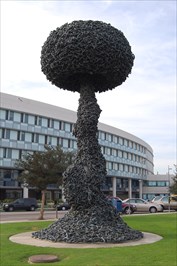


1991 - "Chain Reaction," Santa Monica Civic Center, Santa Monica, California (USA). 26-foot mushroom cloud made from links of a massive chain. Text of plaque: "This is a statement of peace. May it never become an epitaph. Paul Conrad 1991." Designed by Paul Conrad [1924-2010], chief editorial cartoonist for the Los Angeles Times 1964-1993 (& syndicated to 100's of newspapers worldwide). See video. "Gifted to the City of Santa Monica through a $250,000 anonymous donation..." Said to be structurally weak in 2011. "Save Our Sculpture" (SOS) campaign organized by Jerry Peace Activist Rubin.
1998
Date?
Sept. 30, 1998
Oct. 1998 -Mid 1999
May 2002
Jan. 2003
May 2003
July 2005
August 2006
1998 - The Los Alamos Study Group Billboard Campaign, Albuquerque, New Mexico (USA). "Beginning in 1998, visitors to New Mexico could encounter one of the most direct & imaginative efforts to engage New Mexico’s nuclear economy simply by driving out of the Albuquerque International Airport. On the main exit [of] the airport, a large billboard confronted motorists with an image of a rainbow-enhanced desert & the words (see top image at left): 'Welcome to New Mexico: America’s Nuclear Weapons Colony.' Seeking to defamiliarize the desert landscape through shock, the billboard both evokes & inverts the familiar portrait of New Mexico as the 'Land of Enchantment,' a zone of pristine nature & exotic culture. A Web site address on the billboard - www.lasg.org - serves as both a signature & an invitation for viewers to learn more about the scale of the US nuclear project in New Mexico (which includes two of the three national weapons laboratories, the largest missile testing range in the continental USA, the largest arsenal of US nuclear weapons & the most active US nuclear waste dumps). By recontextualizing a centrally located commercial space, the billboard challenges residents & visitors alike to recognize an invisible presence in New Mexico, one that colonizes the austere beauty of the landscape with the nuclear science, toxicity & militarism of a global superpower. The 'Welcome' sign was merely the first salvo in an ongoing billboard campaign orchestrated by the Los Alamos Study Group (LASG), a nonproliferation & peace activism group formed in the waning days of the Cold War. As one of the most vocal nuclear watchdog groups in New Mexico, the LASG has vigorously challenged the post–Cold War consolidation of nuclear weapons science at Los Alamos National Laboratory (LANL) while promoting public education about the accruing environmental effects of the nuclear complex. In a December 2003 discussion in Albuquerque, New Mexico, Greg Mello, the cofounder & director of the LASG, explained to me that the billboards started as a response to a lack of public conversation about the evolution of the nuclear complex in New Mexico at the end of the 1990's. They were also a reaction to the high cost & episodic nature of newspapers, radio & television. Billboards could make a long-term, highly visible statement at, as Mello calculates it, 'one-tenth of a cent per viewer.' Billboards thus offered a new kind of political space that could perform a complex set of ideological tasks in an economical manner. From the start, the goals of the LASG billboard project have been to puncture the normality of the nuclear economy by linking New Mexico’s two leading industries -tourism & nuclear weapons - and to present a stable & highly visible space for political dissent & nuclear critique. For Mello, the project is also intended to 'slow down' the media space in order to encourage public contemplation in a largely commuter & tourist economy, thereby transforming New Mexico’s road culture into a new conceptual space for political critique. As part of a larger activist effort in New Mexico to 'use the tourists to get rid of the plutonium, or the plutonium to get rid of the tourists,' the LASG project, as described by Mello, is interested in provoking a 'more enlightened form of tourism,' one that could ultimately contribute to the LASG’s environmental & nonproliferation efforts. Placed for maximum visibility along the main thoroughfares and highways that connect Albuquerque to Santa Fe & ultimately Los Alamos, the LASG billboards speak directly to occupants of the twenty-five thousand cars that travel Interstate 25 daily. Mello told me that the LASG initially had specific audiences in mind for the billboard campaign, namely, laboratory management (Los Alamos National Laboratory is a Department of Energy institution managed by the University of California), state & federal politicians, & particularly new recruits to the weapons program who might be visiting on job interviews. By visually disrupting the assumed social consensus on the role of the nuclear economy in New Mexico, the LASG seeks to document for policy makers & employees evidence of local resistance & hope for an alternative nuclear future. The billboard project is also a direct response to decreasing access to policy makers & laboratory personnel after a brief period of post–Cold War openness. After a series of security scandals at Los Alamos in 2002), expanding secrecy within the nuclear complex has forced activists to seek an alternative public sphere to mobilize for change. Pursuing the LASG’s political agenda in visual statements that are 48 feet wide by 18 feet high, the billboard campaign has raised a wide range of provocative issues since 1998. The first billboards provided a direct counterdiscourse to the US nuclear project in New Mexico, while more recent efforts have responded to the expanding forms of US militarism under the Bush administration’s 'war on terror.' Evoking the 1930' Works Progress Administration (WPA) aesthetic that is featured in much of the tourist literature about New Mexico, the second LASG billboard asks: 'New Mexico: #1 in Nuclear Weapons, #1 in Poverty - Coincidence?.' Here, the LASG challenges the primary local justification for the nuclear weapons complex - that it provides jobs for New Mexicans. But while LANL currently maintains an annual budget of over $2 billion, New Mexico has for decades competed for the title of poorest state in America. Marshaling equally alarming statistics about violent crime, drug abuse, suicide, alcoholism & the condition of the public school system in New Mexico, the LASG has argued that the nuclear economy has actually prevented other sustainable industries from developing, creating a highly distorted regional economy dangerously reliant on external investments. For Mello, New Mexico is 'held hostage' to Washington, D.C., because of its poverty. Consequently, New Mexico is part of that rural American economic space that relies on toxicity, vice, security & industrial livestock or, as Mello puts it, the 'four P's - plutonium, poker, prisons & pigs.' By arguing that the nuclear complex prevents the development of a sustainable regional economy, the 'Coincidence' billboard also moves the discussion of what constitutes security from the realm of geopolitics to the terms of everyday life...." -- By Joseph Masco in "Public Culture" (2005).


August 2013? - Museum of Peace, Polkovnichiy Island, Semey City (Kazakhstan). Kazakhstan hosted an international conference “From a Nuclear Test Ban to a Nuclear-Weapons-Free World”, August 27- 29, 2012. August 29 was the the UN International Day against Nuclear Testing on August 29, 2012. Part of the conference was held in Semey, including a ground-breaking ceremony for the unique Museum of Peace. The crystal-ball-shaped building will be five stories tall, with a height of 34 metres & a diametre of 24 metres, & will rest in the palms of hands, demonstrating the fragility of life & the need for careful stewardship of the environment. The foundation of the ball in the form of two palms of hands will be made from iron & granite, while the building itself will be constructed of glass. The construction process is scheduled to be completed one year later. Construction costs are estimated at more than one billion tenge & will be provided by the government.

Future - A-Bomb Museum, Washington, DC (USA). "The 'NPT Promotion Committee,' composed of Japanese parliamentarians from various parties, is pursuing the idea of establishing, in Washington, DC, a monument to express the hope of eliminating nuclear weapons as well as a permanent museum to convey the consequences of the atomic bombings of Hiroshima & Nagasaki. The committee aims to unveil the monument at the Nuclear Non-proliferation Treaty (NPT) Review Conference next spring and open the museum sometime next year [2010]."

Pro-Bomb
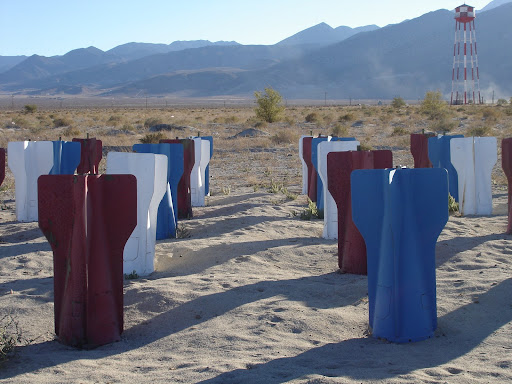
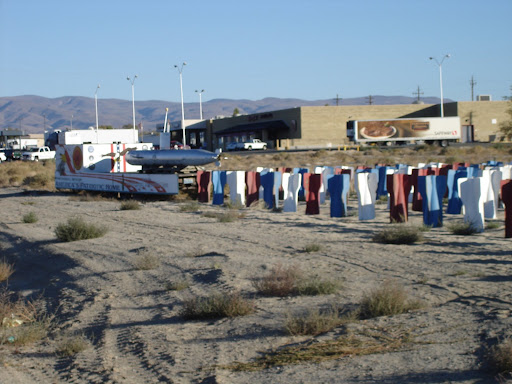
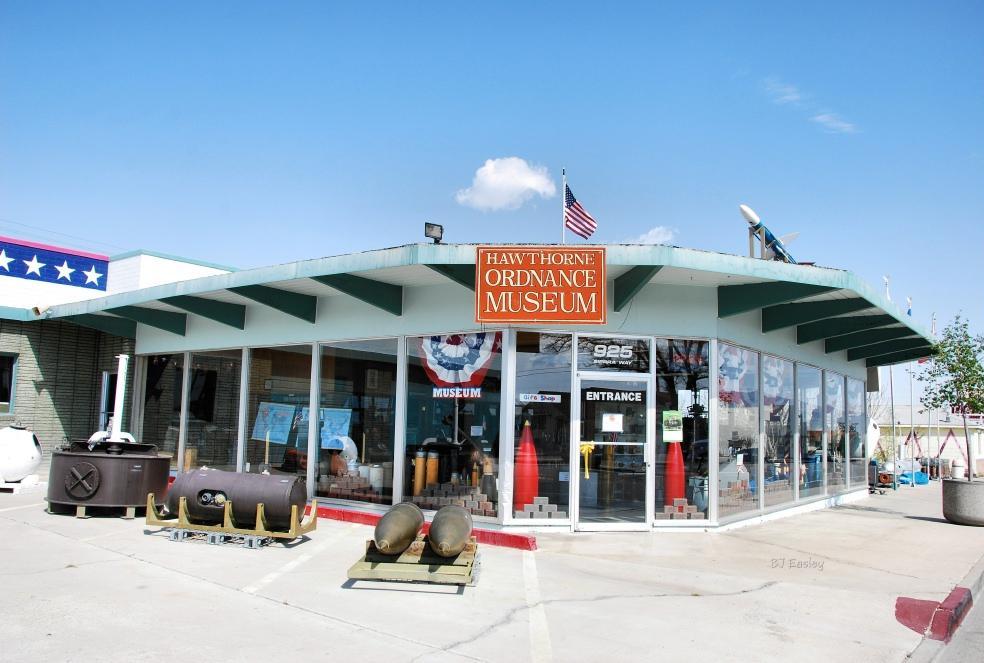

Date? - Entrance, Hawthorne Ordnance Museum. 925 E Street, Hawthorne, Nevada (USA). "[Our] mission is to collect, preserve & exhibit in a patriotic and educational environment, those items that have had a significant impact on the freedom of our country. We focus on the Hawthorne Ammunition Depot for its on-going contribution & support of the US Armed Forces."










